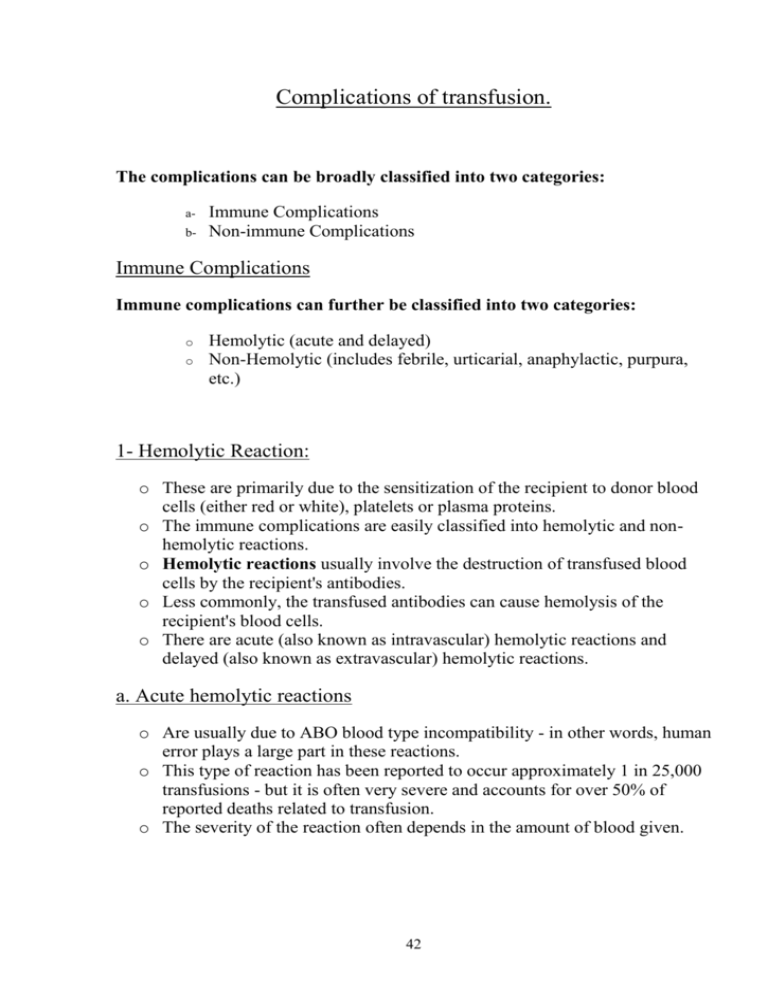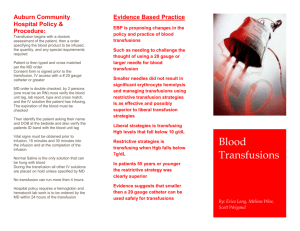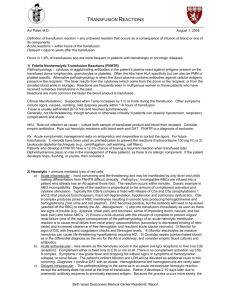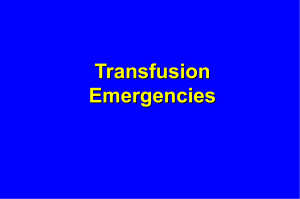HTR
advertisement

Complications of transfusion. The complications can be broadly classified into two categories: ab- Immune Complications Non-immune Complications Immune Complications Immune complications can further be classified into two categories: o o Hemolytic (acute and delayed) Non-Hemolytic (includes febrile, urticarial, anaphylactic, purpura, etc.) 1- Hemolytic Reaction: o These are primarily due to the sensitization of the recipient to donor blood cells (either red or white), platelets or plasma proteins. o The immune complications are easily classified into hemolytic and nonhemolytic reactions. o Hemolytic reactions usually involve the destruction of transfused blood cells by the recipient's antibodies. o Less commonly, the transfused antibodies can cause hemolysis of the recipient's blood cells. o There are acute (also known as intravascular) hemolytic reactions and delayed (also known as extravascular) hemolytic reactions. a. Acute hemolytic reactions o Are usually due to ABO blood type incompatibility - in other words, human error plays a large part in these reactions. o This type of reaction has been reported to occur approximately 1 in 25,000 transfusions - but it is often very severe and accounts for over 50% of reported deaths related to transfusion. o The severity of the reaction often depends in the amount of blood given. 42 Symptoms of acute hemolytic reactions Include chills, fever, nausea, chest pain and flank pain in awake patients. In anesthetized patients, you should look for rise in temperature, unexplained tachycardia, hypotension, hemoglobinuria, oozing in the surgical field, DIC, shock and renal shutdown. Management of acute hemolytic reactions 1. The transfusion should be stopped immediately. 2. The unit should be re-checked. 3. Blood from the recipient patient should be drawn to test for hemoglobin in plasma, repeat compatibility testing and coagulation tests. 4. Check for hemoglobin in the urine. 5. With rapid blood loss, platelets and fresh frozen plasma may be indicated. b. Delayed hemolytic reactions o o o o Are generally mild in comparison. These are caused by antibodies to non-D antigens of the Rh system or to foreign alleles in other systems such as the Kell, Duffy or Kidd antigens. Following a normal, compatible transfusion there is a 1-1.6% chance of developing antibodies to these foreign antibodies. This takes weeks or months to happen - and by that time, the original transfused cells have already been cleared. Re-exposure to the same foreign antigen can then cause an immune response. Thus the reaction is typically delayed from two to twenty-one days after transfusion. Symptoms Are generally mild and include malaise, jaundice, fever, a fall in hematocrit despite transfusion, and an increase in un-conjugated Bilirubin. Diagnosis May be facilitated by the direct Coombs test which can detect the presence of antibodies on the membranes of red cells. 43 Treatment o Is generally supportive. o These reactions occur in approximately 1 in 2,500 transfusions and most often in females with previous exposure secondary to pregnancy. 2- Non-Hemolytic reactions Are due to sensitization of the recipient to donor white cells, platelets or plasma proteins. These reactions include: abcdefgh- Febrile Urticarial Anaphylactic Pulmonary Edema Graft vs. Host Purpura Immune Suppression Iron overload. a. Febrile reactions 1. Are typically due to white cell or platelet sensitization. 2. This reaction is relatively common occurring in 1-3% of all transfusions. 3. The presenting symptom is a rise in body temperature without evidence of hemolysis. 4. Patients with a history of this reaction that require additional transfusions should receive leukocyte poor transfusions. Use of a filter traps most contaminants. 5. The patient should be given antipyretic. b. Urticarial reactions 1. Are characterized by erythema, and itching without fever. 2. Again, this is a relatively common reaction and occurs in about 1% of all transfusions. 3. It is thought to be due to sensitization against plasma proteins. 4. The use of packed red blood cells rather than whole blood has decreased the likelihood of this problem. 5. Treatment is with antihistamines for symptomatic relief. 44 c. Anaphylactic reactions 1. Are rare and occur in about 1 of 150,000 transfusions. 2. These are severe reactions that can occur with very small amounts of blood (a few milliliters). 3. Typically, these reactions occur in IgA-deficient patients with anti-IgA antibodies. These antibodies react to transfusions containing IgA. 4. IgA deficiency occurs in 1 of 600-800 patients in the general population. 5. Patients with known IgA deficiency should receive thoroughly washed packed red blood cells, deglycerolized frozen red cells or IgA free blood units. b- Non-Immune Complications The non-immune complications can also be classified into two broad categories: o o Complications associated with massive blood transfusion Infectious complications 1- Massive Transfusion o Is usually defined as the need to transfuse from one to two times the patient's normal blood volume. o In a "normal" adult, this is the equivalent of 10-20 units. o Potential complications from this include: 1. 2. 3. 4. 5. Coagulopathy Citrate toxicity Hypothermia Acid-base disturbances Changes in serum potassium concentration. Coagulopathy is common with massive transfusion. The most common cause of bleeding following a large volume transfusion is dilution thrombocytopenia. Citrate toxicity results when the citrate in the transfused blood begins to bind calcium in the patient's body. Hypothermia should not occur on a regular basis. Massive transfusion is an absolute indication for the warming of all blood and fluid to body temperature as it is being given. Acid-Base balance can be seen after massive transfusion. 45 Serum potassium can rise as blood is given. 2- Infectious Agents Can be passed along with blood transfusion as well. 1. 2. 3. 4. Hepatitis AIDS Other viral agents (CMV, EBV, HTLV) Parasites and bacteria 46









